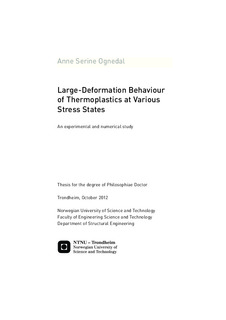| dc.contributor.author | Ognedal, Anne Serine | nb_NO |
| dc.date.accessioned | 2014-12-19T12:01:45Z | |
| dc.date.available | 2014-12-19T12:01:45Z | |
| dc.date.created | 2012-12-19 | nb_NO |
| dc.date.issued | 2012 | nb_NO |
| dc.identifier | 578902 | nb_NO |
| dc.identifier.isbn | 978-82-471-3913-4 (printed ver.) | nb_NO |
| dc.identifier.isbn | 978-82-471-3914-1 (electronic ver.) | nb_NO |
| dc.identifier.uri | http://hdl.handle.net/11250/237164 | |
| dc.description.abstract | The large-deformation behaviour of thermoplastics has been studied by experimental tests and numerical simulations. The work herein is a part of a larger research project concerning constitutive modelling of polymers. A constitutive model for thermoplastics with structural applications has earlier been proposed in the research project. The work presented in this thesis concerns exploration of the capability of the constitutive model to capture the large-deformation behaviour of polymers at various stress states. In addition, some deformation mechanisms are investigated. Two different thermoplastics are addressed: PVC and HDPE. The PVC is an amorphous thermoplastic filled with a volume fraction of particles of about 0.2. The HDPE is a semicrystalline thermoplastic that contains fewer particles. All test specimens are taken from 5 mm and 10 mm thick extruded plates of these two materials.
From uniaxial tension and compression tests it is found that the yield stress of the PVC is pressure sensitive while that of HDPE is not. Furthermore, the stress-strain curve of PVC, in opposite to HDPE, has a peak stress followed by stress-softening and subsequent strain hardening. Reloading of already deformed tensile specimens, does not recall this local stress maximum. This observation is interpreted as a sign of damage rather than physical aging in the material. Reloading of HDPE, on the other hand, recalls the shape of the initial stress-strain curve of the material. During plastic deformation in uniaxial tension the volume change in the PVC is notable while it in the HDPE is almost zero.
Addressing the volume change in PVC, specimens deformed in uniaxial tension are studied in a scanning electron microscope. It is found that the mineral particles have debonded from the PVC matrix and that microscopic voids are formed around the mineral particles in the deformed material. Thus, debonding and void growth are identified as two damage mechanisms in the PVC. Moreover, it is found that the volume change on the macroscale is caused by the void growth on the microscale. Results from numerical unit cell analyses, simulating the interaction between a mineral particle and surrounding polymer matrix, suggest that debonding and void growth can be the cause for the stress drop and the volume change observed in the laboratory tests.
Tensile tests of axisymmetric tensile specimens with notch are carried out on both materials to study the behaviour at presence of a triaxial stress field. Again, it is demonstrated that the yield stress of PVC is pressure dependent while the yield stress of HDPE is not, or at least very little, pressure sensitive. However, during plastic deformation of the notched tensile bars, the volume change is significant for both materials. The dilation increases with the stress triaxiality. Fracture surfaces of fractured specimens clearly suggest that the increase of volume both in the PVC and the HDPE has its origin in void growth.
Biaxial tests are carried out on the PVC and HDPE materials to serve as a basis for validation of the constitutive model. The parameters of the model are determined from uniaxial tension and compression tests. In order to check how this model is applicable for describing other stress states, the biaxial tension tests were subject for numerical simulations. Comparison of the force-displacement curves and the strain fields from the simulations and the laboratory tests show that the model is capable of capturing the large-deformation behaviour.
The test results from the axisymmetric tensile bars with notch were also used for validation of the constitutive model. Comparison of force-displacement curves from laboratory tests and numerical simulations showed that numerical simulations overestimated the maximum force. The overestimation increased with the stress triaxiality, and it was higher for the PVC than for the HDPE. The stress triaxiality seems to enhance some damage that is not captured by the numerical model. | nb_NO |
| dc.language | eng | nb_NO |
| dc.publisher | Norges teknisk-naturvitenskapelige universitet, Fakultet for ingeniørvitenskap og teknologi, Institutt for konstruksjonsteknikk | nb_NO |
| dc.relation.ispartofseries | Doktoravhandlinger ved NTNU, 1503-8181; 2012:298 | nb_NO |
| dc.title | Large-Deformation Behaviour of Thermoplastics at Various Stress States: An experimental and numerical study | nb_NO |
| dc.type | Doctoral thesis | nb_NO |
| dc.contributor.department | Norges teknisk-naturvitenskapelige universitet, Fakultet for ingeniørvitenskap og teknologi, Institutt for konstruksjonsteknikk | nb_NO |
| dc.description.degree | PhD i konstruksjonsteknikk | nb_NO |
| dc.description.degree | PhD in Structural Engineering | en_GB |
